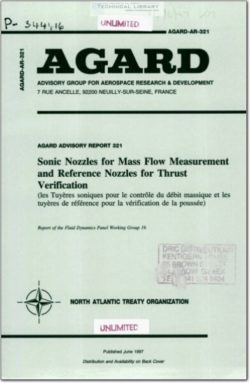AGARD-AR-321

- Version
- 252 Downloads
- 18.61 MB File Size
- 1 File Count
- April 25, 2016 Create Date
- April 25, 2016 Last Updated
Sonic Nozzles for Mass Flow Measurement and Reference Nozzles for Thrust Verification

Accurate measurement of massflow and thrust is essential to the success of windtunnel tests supporting
engine-airframe aerodynamic integration studies. Among other benefits, optimising engine integration
results into reductions of the cruise drag of an aircraft by at least several percent. Hence, mastering this
technique at an early stage of a project allows, within a given set of specification (e.g. the range), to
save on the mass of the aircraft and consequently on its cost — more generally it contributes to reducing
technical/economical risk.
Refinement of experimental techniques contributing to cruise drag prediction, and possibilities offered
by small scale engine simulators are today somewhat limited by the accuracy of massflow and thrust
measurements on reference nozzles, which have to be used at various stages of the experiments. Indeed,
determining thrust-drag balance with an accuracy better than one percent often requires subtracting
large quantities which need to be known individually within a few thousandths. This is today still
difficult to do, even in the simple case of reference nozzles. Moreover, within cooperative programmes,
systematic interfacility bias resulting from slight differences in test methodology can raise complex
issues for the partners.
For these reasons, and although the topic is far from being new, the Fluid Dynamics Panel decided in
1993 to create a Working Group (WG 19) to report on the state-of—the-art and make practical
recommendations.
Progress has been made in the physical understanding of some flow phenomena and a consensus has
been reached on how to proceed, while keeping in mind usual wind tunnel constraints and cost-
effectiveness. As regards practical results, it can be said that measuring gaseous mass flows within
i 0.1% or better is still very difficult. For most tests, however, with reasonable care, bias and random
(repeatability) errors can be kept within i0.1% each. For thrust measurements, these values must
typically be doubled.
| File | Action |
|---|---|
| AGARD-AR-321 Sonic Nozzles for Mass Flow Measurement and Reference Nozzles for Thrust Verification.pdf | Download |

Comment On This Post